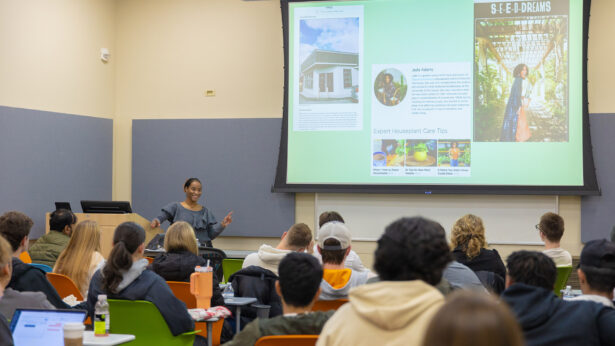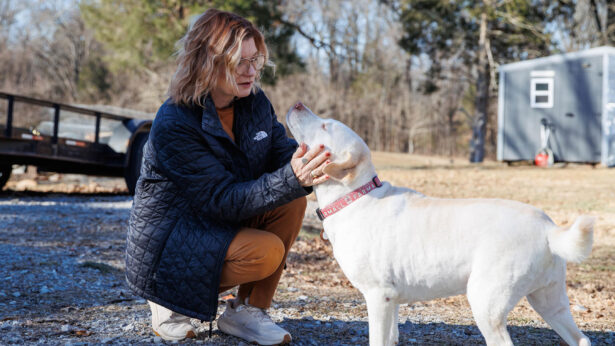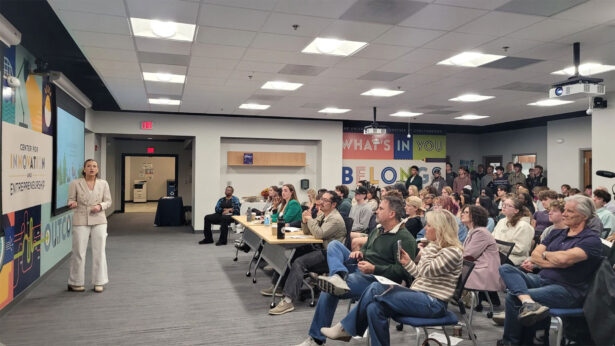Plants that attract fleas off your dog and then devour them.
Wood as strong as steel.
Protein-rich potatoes.
Danger-sensing plants.
Trees that direct search teams to dead bodies.
Biology (CASB), Professor Neal Stewart and Associate Professor Scott Lenaghan dream of such things.
“Synthetic biology imagines an organism as a device that can be reprogrammed to do new things,” Stewart says.
Although it may be a while before you can buy flea-catching plants or see the military using plants as sentries, such innovations are not the stuff of science fiction. They are, very possibly, future realities—thanks to synthetic biology advancements in genome design, DNA synthesis and gene editing.
CASB was co-founded in 2018 by Stewart and Lenaghan.
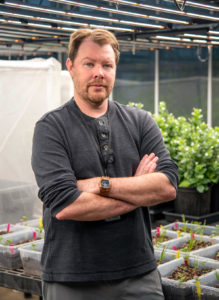
A professor of plant sciences, Stewart holds the Ivan Racheff Chair of Excellence in plant molecular genetics. He has a doctorate in biology from Virginia Tech, did post-doctoral research at the University of Georgia and spent seven years on the faculty at UNC Greensboro before coming to UTIA in 2002.
An associate professor of food science, Lenaghan has a doctorate in biological sciences from Auburn University. He came to UTIA in 2009 as a post-doctoral research associate and has been here ever since.
While many laboratories do synthetic biology, CASB is an innovative leader in using synthetic biology to improve agriculture—to engineer better crop plants and food microbes that contribute to healthy living, advance sustainability and help ensure global food security.
“It’s very applied to try to improve plants and animals in ways they’ve never been improved before,” Stewart says.
Enlisting Plants to Help Soldiers
Funded by the Defense Advanced Research Projects Agency (DARPA), CASB is currently working on science that could one day allow soldiers to use plants to detect chemical weapons or buried land mines.
While they can’t divulge any of the project’s sensitive details, Stewart and Lenaghan say the work is similar to what they’re doing to program plants to detect environmental chemicals or pathogens, like nitrogen or commercial fertilizers.
“The actual methods are super complicated,” Lenaghan says.
To make it understandable to the layperson, he uses an electric circuit as an analogy.
Scientists begin by exposing a plant to a chemical or plant pathogen and observing how it responds at the molecular level. They pinpoint, at the DNA or ribonucleic acid level, what triggers the change. That is the “light switch.”
Scientists then take that “light switch,” hook it up to lab-designed DNA and reinsert it into the plant. That “recircuits” the plant to react in a prescribed way, such as turning a specific color in response to the pathogen or chemical.
Stewart and Lenaghan have already created some tiny test gardens of potato plants whose leaves light up with green fluorescent protein visible under an ultraviolet light when they’re exposed to microbes that cause plant disease.
Their assignment from DARPA builds on this science. They are engineering plants to simultaneously sense and report four relevant environmental stimuli by turning specific colors.
When and how their work might be used by the military are questions Lenaghan and Stewart can’t answer because they don’t know.
“When I hand off a product to the military, they are in charge of deployment,” Lenaghan says.
Trees That Point to Dead Bodies
CASB is also working on a DARPA-funded project to detect changes in plants near dead bodies.
“In the USA, 100,000 people go missing every year. Difficulty in the rapid identification of sites of human decomposition complicates the recovery of bodies, especially in forests,” Stewart, Lenaghan and a host of colleagues wrote in the October 2020 issue of Trends in Plant Science.
Cadavers release chemicals, including large amounts of nitrogen but also drugs and metals unique to the individual, into the soil as they decompose. The scientists’ theory is those chemicals are picked up by nearby plants’ roots and cause changes that can be observed in the foliage.
Working with colleagues from the UT Knoxville Department of Anthropology, the scientists have been doing some field work at the university’s Anthropology Research Facility, better known as the Body Farm. They have been focusing on a particular weedy, invasive plant abundant in the Body Farm: the bush honeysuckle.
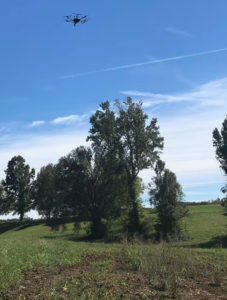
They are using drones equipped with technology that can see things that can’t be observed by the naked eye. These aerial scouts fly over the Body Farm to remotely read subtle changes in the hyper-spectral wavelengths of light being reflected off the plants near decomposing bodies that have been carefully studied by the scientists.
At the same time, Stewart and Lenaghan are doing other experiments to increase their understanding about how plants react to human decomposition.
They are flying drones over plots of switchgrass infused with nitrogen—a chemical released during decomposition—to see how the technology detects
changes in the plant. Using feed mice, typically sold as food for pet snakes, Lenaghan has created a rodent version of the Body Farm where they can conduct controlled experiments.
“We want to make sure that the signal we’re detecting is unique to decomposition,” Lenaghan says. “And we’re still working out what triggers those changes in the leaves and the biology of it.”
Not a Frankenstein
While people are often intrigued by the prospect of using plants to detect hazards or help locate dead bodies, many are still apprehensive about scientists genetically modifying plants and animals in the lab.
Stewart said it’s not Frankenstein’s monster; it’s just the evolution of science.
“People have for centuries made plants and animals serve themselves,” he says.
Over thousands of years, natural mutations and human tinkering have transformed wild teosinte into corn. Likewise, wolves and other dog-like animals evolved—naturally and through careful breeding—into household pets.
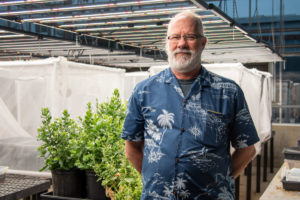
“There is no natural poodle or chihuahua,” he says. “From wolves and other dog-like animals, we’ve gotten Fifi.
“It’s the same thing we’ve been doing,” Stewart says.
Synthetic biology simply uses science and engineering to do it faster and more precisely.
That opens the door to improving agriculture and bolstering food production but also for using plants and microbes in unique and unusual ways—like flea-catching plant walls, trees like steel, improved food crops, danger-sensing plants and trees that help locate dead bodies.
“I think synthetic biology is going to revolutionize agriculture,” Stewart says.

